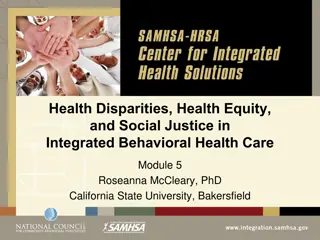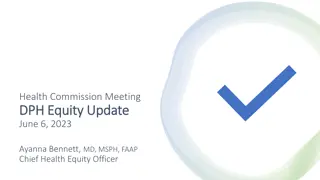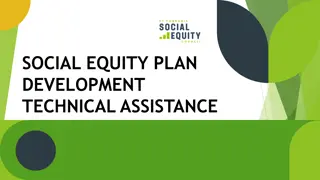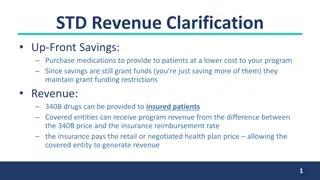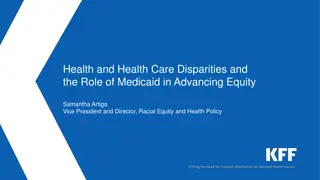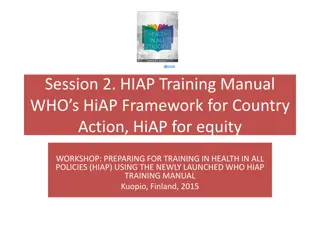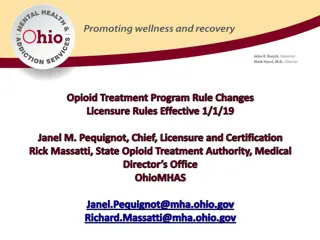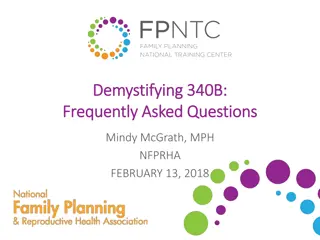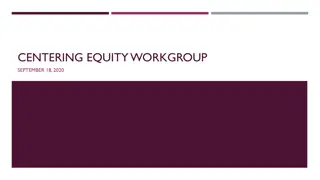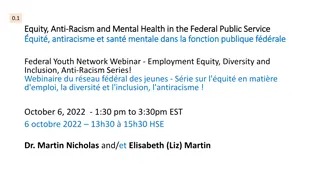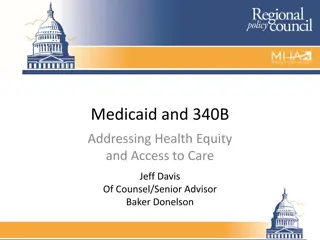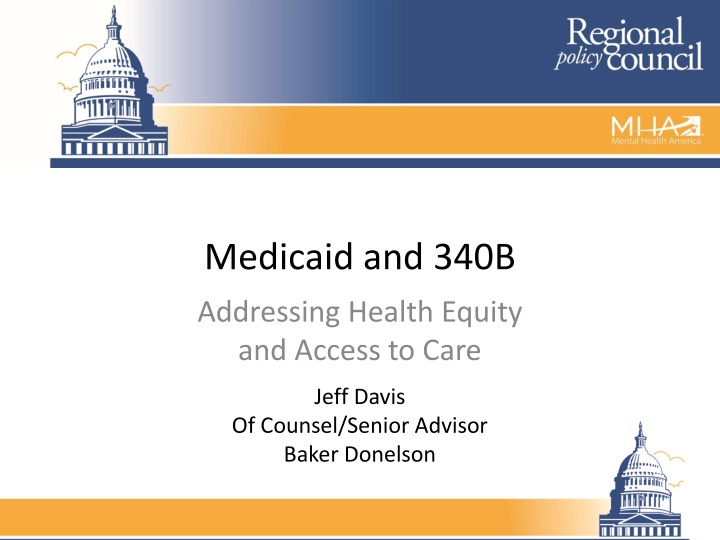
Addressing Health Equity and Access to Care Through Medicaid and 340B Programs
Explore the intersection of Medicaid and the 340B program in addressing health equity, improving access to care, and supporting safety net providers. Learn about the history of the 340B program, its background, providers, and the impact of 340B hospitals in serving low-income populations.
Download Presentation

Please find below an Image/Link to download the presentation.
The content on the website is provided AS IS for your information and personal use only. It may not be sold, licensed, or shared on other websites without obtaining consent from the author. If you encounter any issues during the download, it is possible that the publisher has removed the file from their server.
You are allowed to download the files provided on this website for personal or commercial use, subject to the condition that they are used lawfully. All files are the property of their respective owners.
The content on the website is provided AS IS for your information and personal use only. It may not be sold, licensed, or shared on other websites without obtaining consent from the author.
E N D
Presentation Transcript
Medicaid and 340B Addressing Health Equity and Access to Care Jeff Davis Of Counsel/Senior Advisor Baker Donelson
Medicaid and the Safety Net Safety net providers treat high volumes of uninsured, Medicaid, and other vulnerable patients Medicaid expansion under the ACA expanded the role of Medicaid in the safety net Medicaid is the backbone of America s health care safety net
Medicaid and 340B 1965 1990 1992 Medicaid Medicaid Drug Rebate Program 340B Drug Pricing Program
History of 340B Program Congress enacted 340B into law, signed by President Bush 1992 Congress adds children s hospitals to 340B 2005 Congress expands 340B to include rural hospitals and free-standing cancer hospitals 2010
340B Background 340B requires drug manufacturers participating in Medicaid and Medicare Part B to sell outpatient drugs at discounted prices to 340B providers 340B provides financial resources to providers treating high volumes of uninsured, Medicaid, and underinsured people Providers use 340B savings to provide clinical and pharmacy services and support access to care
340B Providers Clinics and Health Centers Hospitals Federally Qualified Health Center FQHC Look-Alike Ryan White HIV/AIDS Grantee STD Clinic Title X Family Planning Clinic Hemophilia Treatment Center Tuberculosis Clinic Black Lung Clinic Native Hawaiian Health Center Tribal/Urban Indian Health Center Disproportionate Share (DSH) Free-Standing Children s Free-Standing Cancer Critical access Rural Referral Center Sole Community Hospital Must be public, non-profit, or granted governmental powers and must treat high-volume low-income patients or be rural
340B Hospitals 340B hospitals treat significantly more low-income people Low-income people make up 42% of 340B DSH hospitals patient load versus 27% for non-340B hospitals 340B DSH Hospitals represent only 38% of acute care hospitals, yet are responsible for 60% of the nation s uncompensated and unreimbursed care more than $26 billion a year 340B hospitals provide more uncompensated and unreimbursed care
340B Savings 340B hospitals report using program savings to Provide clinical, pharmacy, and auxiliary services (transportation, translation, social services) Provide uncompensated care and offset low reimbursement from Medicaid Provide free or discounted drugs Rural hospitals Keep the doors open
340B and Mental Health 340B Hospitals Are 64% more likely than non-340B hospitals to provide psychiatric emergency services 59% more likely to offer psychiatric geriatric services More than 2.5 times more likely to provide psychiatric child and adolescent services
340B Challenges More than 20 bills in last Congress, many of which would have restricted 340B Administration has floated possible changes that would restrict 340B Interest in 340B transparency continues
Contact Information Jeff Davis Of Counsel/Senior Advisor Baker Donelson jeffdavis@bakerdonelson.com 202-508-3414
Medicaid and 340B Addressing Health Equity and Access to Care Courtney Lang, JD - Langco + Partners
Why Health Equity and Why 340B? Health Equity Defined: Everyone has the opportunity to attain their highest level of health (APHA) According to Healthy People 2020, we are tasked to achieve health equity, eliminate disparities, and improve the health of all groups. Health equity means that everyone has a fair and just opportunity to be healthy (RWJF) Together our understanding of health equity makes 340B even more important We seek policy and advocacy solutions that bridge the divide for communities with the greatest need The 340B drug pricing program is rooted in serving low income patients, those in the greatest need and is a fundamental program to protecting the U.S. health care safety net.
340B: Meeting Community Mental Health Needs Access to care Addressing transportation constraints Delivering emergency psychiatric care and support Safety-net hospitals are more often embedded in the communities they serve, making accessing care easy and readily available to patients 340B savings allows hospitals to provide services such as transportation support, outpatient behavioral programming and increasing psychiatric health provider, such as nurse practitioners on staff 340B hospitals are more likely than non-340B hospitals to provide emergency psychiatric services. 340B works toward eliminating access challenges by offering service lines such as acute and longer-term psychiatric beds Safety-net hospitals are using their program savings to address diverse needs and offer care tailored to specific patient populations
SDOH and 340B Advocacy Advocacy, coalition building, etc. Mold abatement, Uber / Lyft, etc. Charity care, Medicaid, etc. Meeting Individual Social Needs Falls Short Of Addressing Social Determinants Of Health, " Health Affairs Blog, January 16, 2019. DOI: 10.1377/hblog20190115.234942
Mental Health Advocacy and Addressing Complex Chronic Disease Leveraging peer support Providing community education to reduce stigma Understanding comorbidities and the complex nature of disease presentation Augmenting outpatient care Leading Outpatient Behavioral Health Integration Models Some hospitals and health systems are developing formal behavioral health integration models for their PCPs. Three typical models from the most integrated to least integrated.
Whole Person Mental Health Asthma/ Pulmonary Cancer Prevention & Treatment Resilience & Recovery Infectious Disease Heart Disease/ Hypertension Whole Person Liver Diabetes Renal Oral Health Addiction
340B Always Matters to Patient Care Safety-Net Hospitals Access to Care Rural Communities 340B hospitals are on the frontlines of treating underserved communities and people suffering from undertreated, chronic, and life threatening diseases and conditions. 340B helps hospitals serve low- income and rural patients. Geography matters 340B institutions must show they treat large numbers of low- income patients or serve people in rural communities to qualify for the program. The savings from drugs purchased at discounted prices are used for patient care any changes to the 340B program could eliminate access to treatment and services. Any cuts to 340B could result in diminished services provided to these patients. 340B restrictions could harm access to care for patients whose health care needs are delivered in rural communities.
Saving Rural Hospitals 113 rural hospitals closed since 2010 More than 1,000 rural hospitals in 340B Many are very small and the only hospital in their community 93% report using 340B savings to keep their doors open
#Protect340B Partner with local 340B hospitals Focus advocacy on equity for ALL patients to have access to quality mental health care (regardless of socio-economic status or geography) Oppose efforts in Congress and states to limit the scope of 340B Ask to MHA networks is to Make a WISE Choice and Support 340B! Write Issue Send a letter to the Hill expressing concerns about the potential negative impact on patient care Educate if not willing to be active an op-ed expressing concern against harmful proposed legislation a statement or newsletter post on how the legislation could harm patients e.g. educating divergent viewpoints helps shift to or stabilize a neutral position Goal: Minimize negative response to the 340B program; engage in dialogue that produces balance to stakeholder outreach; and encourage support for protecting the 340B program
Resources https://www.340bhealth.org/
340B in Action: Southern Ohio Medical Center (Portsmouth, Ohio) The 340B prescription drug program is a vital lifeline for safety-net providers, supporting critical health services in our communities. The program is narrowly tailored to reach only hospitals that provide a high level of services to low- income individuals or that serve isolated rural communities. Savings from the 340B program help hospitals meet the healthcare needs of vulnerable patients across the country. Congress should preserve and protect the 340B program as an essential part of the safety-net that does not rely on taxpayer dollars. About us: Southern Ohio Medical Center (SOMC) is a 240-bed medical surgical hospital in Southern Ohio that provides treatment to all patients, regardless of their ability to pay. Without 340B, many services would be scaled back and patients would have to drive long distances to receive the same level of care that SOMC provides. We use our 340B savings to: Expand medical care to remote service areas, including West Union and Waverly, Ohio, and Vanceburg, Kentucky. Support a Patient Prescription Assistance Plan that fills prescriptions at our 340B cost. This benefits uninsured patients, or those unable to afford costly medications. Embed a pharmacist in our Cancer Center, Infectious Disease Department, and Pulmonary Critical Care Department to provide consultation for complex medication therapies and improve patient outcomes. Deliver medication along with education to the patient s bedside upon discharge. Our goal is to improve medication adherence. Offer medication take-home-packs to patients leaving the Emergency Room, so that they have enough medicine through the evening until retail pharmacies open the next day. Maintain current services so uninsured patients do not have to travel far for care as we are the only inpatient facility in our area. 340B by the Numbers $9M Our annual approximate 340B savings 2,682 Employees Percent of our patients on Medicaid, Medicare, or uninsured 76.4% Amount of uncompensated care we provide per year $36M Direct savings to patients for discounted drugs last year $446K 90 Number of 340B hospitals in Ohio
Contact Information Courtney Lang, JD Langco + Partners advocacy@langcopartners.com


